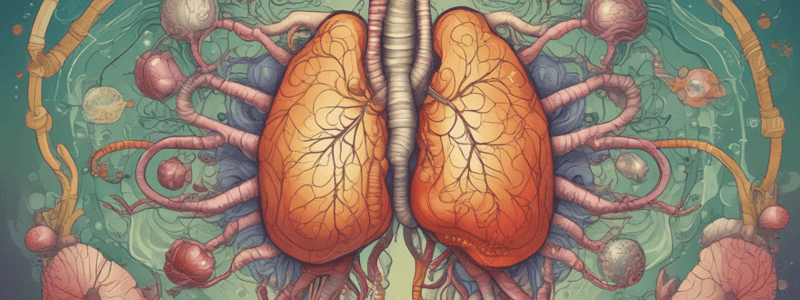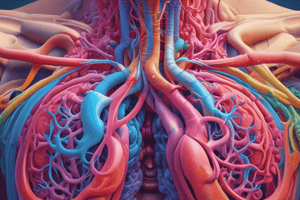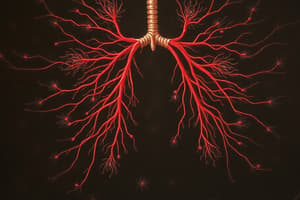Podcast
Questions and Answers
Which of the following is NOT a type of respiration?
Which of the following is NOT a type of respiration?
- Cellular respiration
- Breathing
- Respiratory systems
- Aerobic exercise (correct)
What is the main function of respiratory systems?
What is the main function of respiratory systems?
- Moving oxygen into body tissues and removing carbon dioxide (correct)
- Filtering blood
- Producing hormones
- Digesting food
Which of the following is NOT a part of the respiratory system?
Which of the following is NOT a part of the respiratory system?
- Esophagus (correct)
- Trachea
- Alveoli
- Bronchi
What prevents alveolar walls from collapsing and sticking together?
What prevents alveolar walls from collapsing and sticking together?
What type of epithelium lines the entire respiratory tract?
What type of epithelium lines the entire respiratory tract?
Which condition is characterized by infection in the lung parenchyma?
Which condition is characterized by infection in the lung parenchyma?
Which of the following is impaired when pneumonia develops?
Which of the following is impaired when pneumonia develops?
Which of the following is NOT a type of pneumonia based on anatomic classification?
Which of the following is NOT a type of pneumonia based on anatomic classification?
What type of pneumonia is often a complication of bronchiolitis or chronic bronchitis?
What type of pneumonia is often a complication of bronchiolitis or chronic bronchitis?
What is the primary function of cilia in the respiratory tract?
What is the primary function of cilia in the respiratory tract?
What is a common cause of granulomatous chronic pneumonia?
What is a common cause of granulomatous chronic pneumonia?
Which of the following pathogens can cause pneumonia in immunocompromised hosts?
Which of the following pathogens can cause pneumonia in immunocompromised hosts?
What is a typical feature of community-acquired acute pneumonia?
What is a typical feature of community-acquired acute pneumonia?
What is a characteristic of atypical pneumonia?
What is a characteristic of atypical pneumonia?
What is a common diagnostic feature of community-acquired acute pneumonia on a chest X-ray?
What is a common diagnostic feature of community-acquired acute pneumonia on a chest X-ray?
What is the primary treatment for bacterial pneumonia?
What is the primary treatment for bacterial pneumonia?
What is a characteristic of the red hepatization stage of pneumonia?
What is a characteristic of the red hepatization stage of pneumonia?
Which pathogen is NOT typically associated with nosocomial pneumonia?
Which pathogen is NOT typically associated with nosocomial pneumonia?
What is the result of chronic pneumonia?
What is the result of chronic pneumonia?
What is the clinical significance of clubbing of fingers in lung abscess?
What is the clinical significance of clubbing of fingers in lung abscess?
Which type of pneumonia is characterized by multiple foci of isolated acute consolidation?
Which type of pneumonia is characterized by multiple foci of isolated acute consolidation?
Which pathogen is the most common cause of community-acquired acute pneumonia?
Which pathogen is the most common cause of community-acquired acute pneumonia?
Which lobe is most frequently involved in community-acquired acute pneumonia?
Which lobe is most frequently involved in community-acquired acute pneumonia?
Which stage of pneumonia is characterized by liver-like consistency of the lung?
Which stage of pneumonia is characterized by liver-like consistency of the lung?
Which of the following is NOT a common etiology of bronchopneumonia?
Which of the following is NOT a common etiology of bronchopneumonia?
Aspiration pneumonia is partly caused by:
Aspiration pneumonia is partly caused by:
A lung abscess is characterized by:
A lung abscess is characterized by:
Which factor is the most frequent cause of lung abscess?
Which factor is the most frequent cause of lung abscess?
Clinical features of lung abscess include all EXCEPT:
Clinical features of lung abscess include all EXCEPT:
Which type of pneumonia often affects individuals at which stages of life?
Which type of pneumonia often affects individuals at which stages of life?
Flashcards are hidden until you start studying
Study Notes
Basic Concepts
- Respiratory systems have the main function of moving oxygen into body tissues and removing carbon dioxide
- Aerobic exercise is not a type of respiration
- Breathing, cellular respiration, and respiratory systems are all related to respiration
Parts of the Respiratory System
- The respiratory system includes trachea, bronchi, and alveoli, but not esophagus
- Surfactant prevents alveolar walls from collapsing and sticking together
- The entire respiratory tract is lined by pseudostratified ciliated columnar epithelium
Pulmonary Infections
- Pneumonia is characterized by infection in the lung parenchyma
- Pneumonia can develop when defense mechanisms are impaired
- Pneumonia can lead to complications such as abscess formation, pleural empyema, and organization & fibrosis
Types of Pneumonia
- Bronchopneumonia and lobar pneumonia are types of pneumonia based on anatomic classification
- Viral pneumonia is not a type of pneumonia based on anatomic classification
- Bronchopneumonia is often a complication of bronchiolitis or chronic bronchitis and is characterized by multiple foci of isolated acute consolidation
Pneumonia Pathogens
- Streptococcus pneumoniae is the most common cause of community-acquired acute pneumonia
- Mycoplasma pneumoniae is commonly associated with community-acquired atypical pneumonia
- Nosocomial pneumonia is often caused by methicillin-resistant Staphylococcus aureus
Clinical Features and Outcomes
- Pneumonia symptoms include high fever, shaking chills, and pleuritic chest pain
- Complications of pneumonia include abscess formation, pleural empyema, and organization & fibrosis
Community-Acquired Acute Pneumonias
- The right middle lobe and lower lobe are frequently involved in community-acquired acute pneumonia
- S. pneumoniae pneumonia evolves through four stages
Bronchopneumonia
- Bronchopneumonia often affects infants and elderly
- Staphylococcus, Streptococcus, and Pneumococcus are common etiologies of bronchopneumonia
- Rhinovirus is not a common etiology of bronchopneumonia
Aspiration Pneumonia
- Aspiration pneumonia is partly caused by chemical injury and bacterial infection
- A common complication of aspiration pneumonia is abscess formation
Lung Abscess
- A lung abscess is characterized by necrosis of lung tissue
- The most frequent cause of lung abscess is aspiration of infective material
- Clinical features of lung abscess include copious foul-smelling purulent sputum, hemoptysis, and spiking fever
Chronic Pneumonia
- Mycobacterium tuberculosis is associated with chronic pneumonia
- Granulomatous chronic pneumonia can be caused by Histoplasma capsulatum, Coccidioides immitis, and Blastomyces dermatitidis
Pneumonia in Immunocompromised Hosts
- Pneumonia in immunocompromised hosts can be caused by Cytomegalovirus, Pneumocystis jiroveci, and Mycobacterium avium-intracellulare
Clinical Presentation
- Typical community-acquired acute pneumonia presents with high fever and shaking chills
- Atypical pneumonia typically presents with moderate amounts of sputum
Diagnosis and Treatment
- A common diagnostic feature of community-acquired acute pneumonia on a chest X-ray is consolidation of lung lobes
- The primary treatment for bacterial pneumonia typically involves antibiotics
Studying That Suits You
Use AI to generate personalized quizzes and flashcards to suit your learning preferences.




